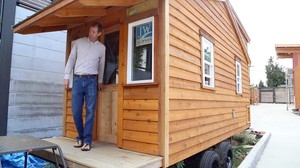Nestled in a tree-shrouded urban neighborhood of Seattle, Madrona Grace Presbyterian Church has launched an innovative program aimed at helping alleviate homelessness in the city. Partnering with Mary’s Place, a local homeless agency, and a nearby vocational school, the congregation is expanding its ability to house and staff its own homeless shelter, Julia’s Place, by placing a tiny house on church property.
The Rev. Mark Zimmerly, co-pastor of Madrona Grace, says mission is a priority for the congregation, especially expanding mission in its own neighborhood. In addition to Julia’s Place and the tiny house project, the church boasts a small community garden, is launching a “dinner church” worshiping community, and is offering the church for use by community groups, a ministry the congregation is calling Madrona Commons.
The first home built for the tiny house ministry, known as NIMBY—Neighbor In My Back Yard—will initially house a Julia’s Place staff person. The homeless shelter currently houses six homeless families and one staff person. The tiny house on church property will allow the staff people to rotate shifts and have some time away from the shelter.
Zimmerly says the home is paid for, and funds have already been raised for a second home, which will likely be placed on a church member’s property to house a homeless individual or family.
The designs Madrona Grace is using are complete homes, but in miniature. The model under construction includes a sleeping loft; a kitchen with stove and refrigerator; a full bath with shower, sink and a composting toilet; a clothes washer and dryer; and living space—all in a highly energy efficient 131 square feet.
Depending on the features of the home, each tiny house costs between $12,000 and $20,000. The church is responsible for material costs, and the Wood Technology Center of Seattle Central College is providing all the labor, building the homes to specifications provided by the church. Zimmerly says the school is happy to have the work building tiny houses, which is an emerging industry for their graduates.
“This is a way we can continue to live out Christ’s call to us to serve those who are most in need,” says Zimmerly. “With this project, we’re trying to become more personal in our discipleship and to make it clear that Jesus calls us to make changes in our individual lives, as well as our corporate life together.”
----
A full description of the project goals and frequently asked questions are available on Madrona Grace Presbyterian’s website.

